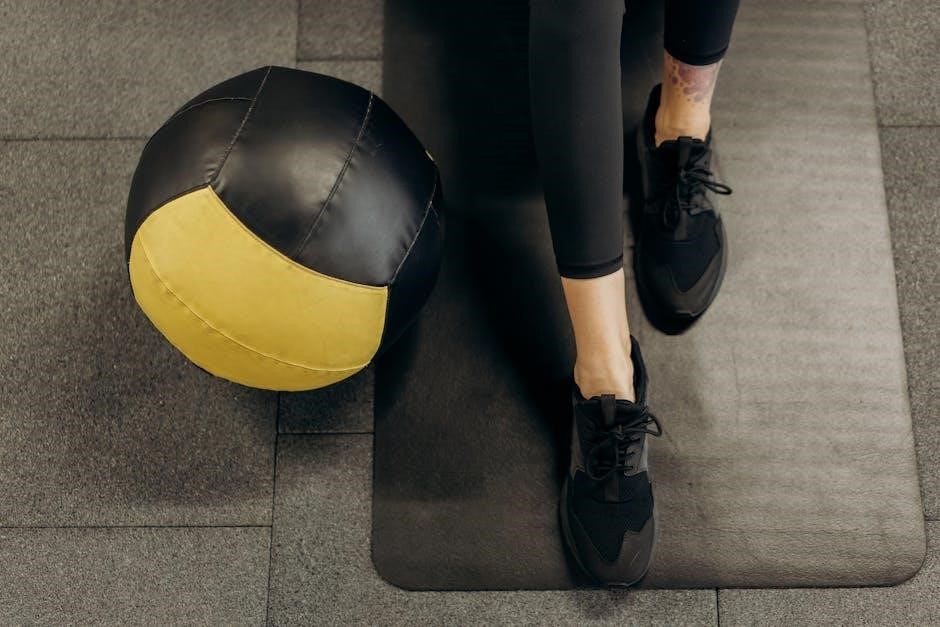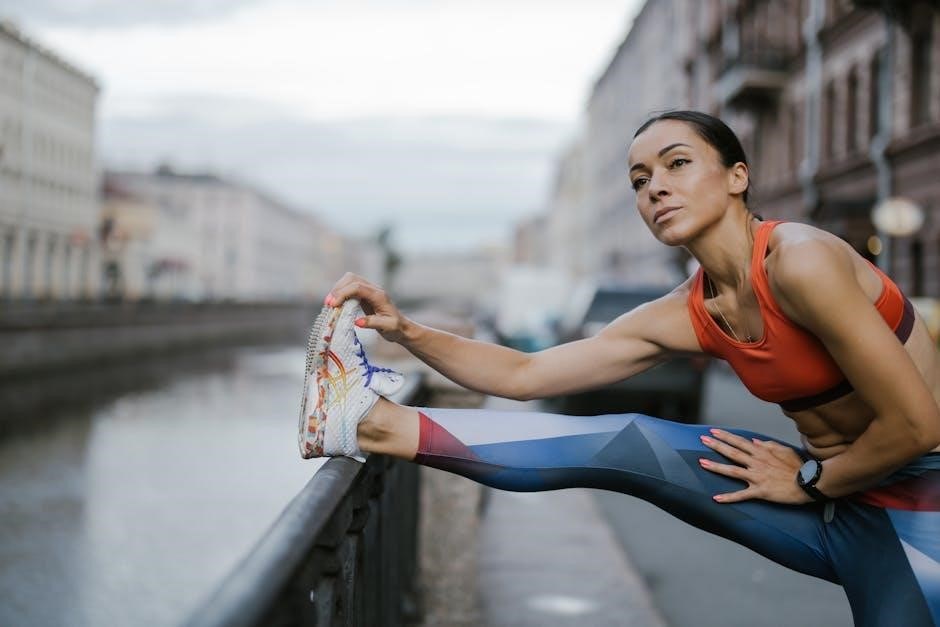
stroke exercises for legs pdf
Following a stroke, leg weakness is a common challenge.
These leg exercises, often available in PDF format, are
crucial for regaining mobility. They focus on rebuilding
strength and coordination. Starting these exercises early
and consistently is vital for effective stroke recovery.
Many resources provide structured programs to guide rehabilitation.
Understanding Stroke-Related Leg Weakness
Stroke-related leg weakness, or hemiparesis, arises from damage
to the brain areas controlling motor function. This impairment
affects the ability to move and control leg muscles, impacting
balance, walking, and overall mobility. The severity of
weakness varies depending on the stroke’s location and extent
of damage. Stroke can disrupt the communication pathways between
the brain and legs, leading to muscle stiffness, spasticity,
and reduced coordination.
Understanding these neurological impacts is crucial for designing
effective leg exercise programs. Rehabilitation aims to rewire
the brain, strengthening neural pathways and restoring motor
function. Identifying specific muscle weaknesses and addressing
spasticity are essential components of stroke recovery. Specialized
exercises often target individual muscle groups and involve
repetitive movements to promote neuroplasticity. With consistent
effort and targeted exercises, individuals can improve leg
strength, coordination, and regain independence in mobility.
PDF resources often provide detailed information on the neurological
basis of stroke-related leg weakness.

Benefits of Leg Exercises After Stroke
Engaging in regular leg exercises after a stroke offers a
multitude of benefits. These exercises play a vital role in
improving muscle strength, coordination, and overall mobility.
By consistently working the leg muscles, stroke survivors can
regain better balance, reduce the risk of falls, and enhance
their ability to walk independently. Leg exercises also improve
circulation, preventing blood clots and promoting cardiovascular
health.
Moreover, these exercises can help reduce spasticity, a common
condition after stroke that causes muscle stiffness. Consistent
exercise promotes neuroplasticity, aiding the brain in forming
new neural connections to compensate for damaged areas. Furthermore,
leg exercises can improve bone density, preventing osteoporosis,
and enhance overall physical fitness. The psychological benefits
are also significant, as regaining mobility boosts confidence,
reduces depression, and improves quality of life. PDF resources
often highlight these benefits and provide structured exercise
programs.

Types of Leg Exercises for Stroke Recovery
Various leg exercises aid stroke recovery, including seated,
standing, and lying down routines. These exercises target
strength, flexibility, and coordination. PDF guides often
detail specific movements and progressions. A physical therapist
can tailor exercises to individual needs.
Seated Leg Exercises
Seated leg exercises are a great starting point for stroke
patients with limited mobility. These exercises can be
performed in a chair, making them accessible and safe;
One common exercise is seated marching, where the patient
lifts each leg up towards their chest, mimicking a marching
motion. Ankle slides can also be done, where the patient
slides their foot along the floor towards their body.
Another helpful exercise is knee extensions, where the patient
straightens their leg out in front of them, holding the
position briefly before bending the knee again. These seated
exercises help improve leg strength and range of motion while
minimizing the risk of falls. As strength increases, ankle
weights can be added to increase resistance. Remember to
consult a physical therapist before starting any exercise program.
Standing Leg Exercises
Standing leg exercises mark a progression in stroke recovery,
requiring improved balance and strength. It’s crucial to have
a stable surface nearby for support. Heel raises are a simple
exercise, involving lifting up onto the toes and back down.
Mini squats, where the patient bends their knees slightly,
strengthen leg muscles. Standing leg extensions, holding onto
a chair, can improve leg strength and balance. Weight shifting,
moving weight from one leg to the other, enhances balance.
Partial lunges, stepping one leg back while keeping the other
bent, can be incorporated as strength increases. These exercises
improve standing balance and coordination. Always prioritize
safety and have assistance nearby if needed. As strength improves,
increase repetitions or resistance bands can be added.
Consulting a physical therapist is essential before starting
these exercises.
Lying Down Leg Exercises
Lying down leg exercises are often the initial step in
rehabilitating leg strength after a stroke. These exercises
minimize the risk of falls and allow focus on muscle activation.
Heel slides, where the patient slides their heel along the bed
towards their buttocks, help to improve knee flexion. Ankle pumps,
involving pointing the toes up and down, improve circulation and
ankle flexibility. Leg raises, lifting one leg off the bed while
keeping it straight, build hip flexor strength. Hip abduction,
moving the leg out to the side while lying down, targets the
outer hip muscles. Bridging, lifting the hips off the bed while
keeping the knees bent, strengthens the glutes and hamstrings.
These exercises can be modified based on individual abilities.
Resistance bands can be added for increased challenge. A physical
therapist can guide the proper form and progression. Consistency
is key in achieving optimal results.
Sample Leg Exercise Program (PDF Resources)
Many valuable resources, often in PDF format, offer structured
leg exercise programs for stroke recovery. These programs outline
a series of exercises designed to improve leg strength, mobility,
and coordination. A typical program may include a combination of
seated, standing, and lying down exercises. Each exercise is
usually described with clear instructions and illustrations, making
it easy to follow. The PDFs often provide guidance on the number
of repetitions and sets to perform, as well as recommendations
for progression as strength improves. Some programs also incorporate
stretching exercises to maintain flexibility. These resources can
be found on websites of stroke organizations, rehabilitation
centers, and healthcare providers. It’s important to choose a
program that is appropriate for your current level of ability
and to consult with a physical therapist before starting any new
exercise regimen.

Importance of Stretching for Leg Muscles
Stretching leg muscles is critically important after a stroke due
to the potential for stiffness and contractures. Stroke-related
muscle imbalances can lead to shortening of muscles, limiting
range of motion. Regular stretching helps maintain muscle length
and flexibility, preventing further complications. Stretching
exercises also improve blood circulation to the muscles, promoting
healing and reducing pain. Incorporating stretches into a
rehabilitation program can enhance the effectiveness of other
exercises by allowing for greater movement and engagement.
Furthermore, stretching can reduce spasticity, a common condition
after stroke that causes muscles to become stiff and difficult to
move. Stretching exercises often target major leg muscle groups
like hamstrings, quadriceps, and calf muscles. Holding each stretch
for an adequate duration, usually 20-30 seconds, is essential to
allow the muscle fibers to lengthen. Consulting with a physical
therapist will ensure proper stretching techniques.

Using Assistive Devices During Exercise
Assistive devices play a crucial role in facilitating leg exercises
after a stroke, especially in the initial stages of recovery. These
devices provide support, stability, and assistance, enabling
individuals to perform exercises safely and effectively. Common
assistive devices include walkers, canes, parallel bars, and ankle-foot
orthoses (AFOs). Walkers and canes offer stability during standing
exercises, reducing the risk of falls. Parallel bars provide a
secure environment for practicing walking and balance exercises.
AFOs support the ankle and foot, improving alignment and facilitating
weight-bearing. The use of assistive devices allows individuals to
gradually increase their strength and coordination while minimizing
the risk of injury. These devices can also help compensate for
muscle weakness or impaired balance, enabling individuals to engage
in a wider range of exercises. Selecting the appropriate assistive
device should be based on an individual’s specific needs and
abilities, in consultation with a physical therapist.
Progression and Modification of Exercises
Progression and modification are essential components of a successful
leg exercise program following a stroke. As strength and
coordination improve, exercises should be progressively advanced to
challenge the individual and promote further gains. This can involve
increasing the number of repetitions, sets, or the duration of each
exercise. Adding resistance, such as ankle weights or resistance
bands, can also enhance the challenge. Conversely, exercises may
need to be modified if they are too difficult or cause pain.
Modifications can include reducing the range of motion, decreasing
the resistance, or providing additional support. It’s crucial to
listen to your body and avoid pushing yourself too hard, especially
in the early stages of recovery. Working with a physical therapist
is highly recommended, as they can assess your progress and adjust
the exercise program accordingly. They can also provide guidance on
proper form and technique, minimizing the risk of injury. The goal
is to gradually increase the intensity and complexity of the
exercises while ensuring safety and comfort.
Safety Precautions and Considerations
Prioritizing safety is paramount when undertaking leg exercises post-stroke.
Before beginning any exercise program, consulting with a healthcare
professional, such as a doctor or physical therapist, is crucial to
ensure the exercises are appropriate for your specific condition and
recovery stage. Always begin with a warm-up to prepare the muscles
for activity and reduce the risk of injury. Choose a safe
environment, free from obstacles and with adequate space to move.
Wear supportive shoes and clothing that allows for unrestricted
movement. Be mindful of your body’s signals and stop immediately if
you experience pain, dizziness, or shortness of breath. Avoid
overexertion and gradually increase the intensity and duration of
exercises over time. If you have balance issues, use assistive
devices such as a walker or cane for support. Ensure adequate
hydration by drinking plenty of water before, during, and after
exercise. If you have any underlying medical conditions, such as
heart problems or diabetes, discuss any potential risks with your
healthcare provider. Proper form and technique are essential to
prevent injuries, so consider working with a physical therapist who
can provide guidance. Remember that recovery is a gradual process,
and patience and consistency are key.
Consulting with a Physical Therapist
Seeking guidance from a physical therapist (PT) is highly recommended
for individuals recovering from a stroke, particularly when focusing
on leg exercises. A PT possesses specialized knowledge and expertise
in rehabilitation techniques, enabling them to create a tailored
exercise program based on your specific needs and abilities. During
an initial consultation, the PT will assess your muscle strength,
range of motion, balance, and overall functional abilities. This
assessment helps them identify areas of weakness and develop
targeted exercises to address these deficits. A PT can provide
personalized instruction on proper exercise form and technique,
minimizing the risk of injury and maximizing the effectiveness of
each exercise. They can also monitor your progress and adjust the
exercise program as needed to ensure you are continuously
challenged and making gains. Furthermore, a PT can educate you on
strategies for managing pain, preventing complications, and
incorporating leg exercises into your daily routine. They can also
offer guidance on assistive devices or adaptive equipment that may
be beneficial. The expertise of a physical therapist is invaluable
in optimizing your recovery and helping you regain independence and
mobility after a stroke.


Leave a Reply
You must be logged in to post a comment.